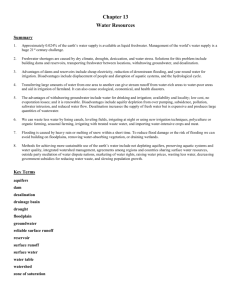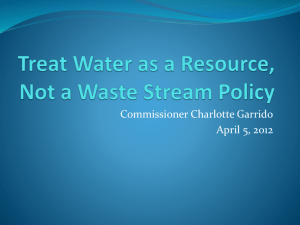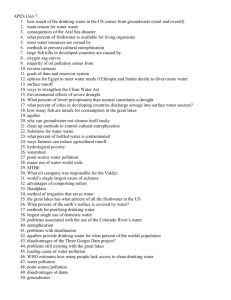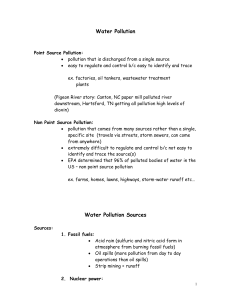Pencemaran Air
advertisement
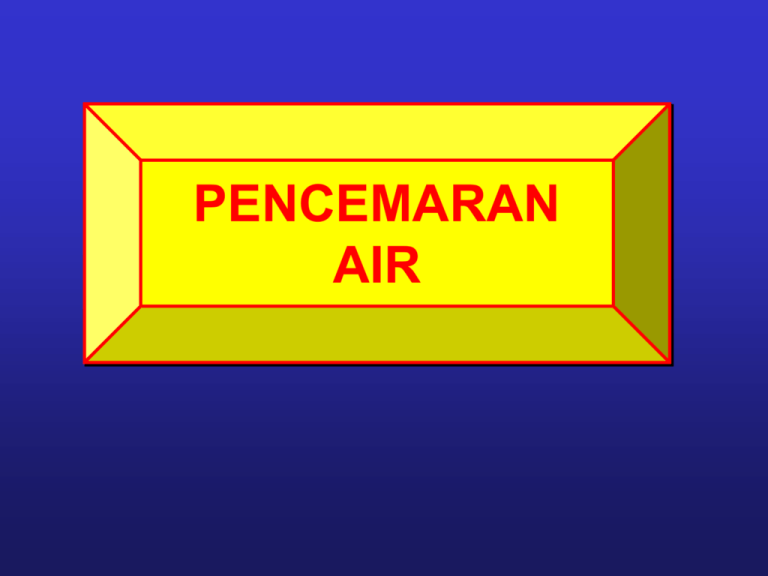
PENCEMARAN AIR Air, Udara, Lahan …. The solution to pollution is dilution. Konsep-Konsep Penting Types, sources, and effects of water pollutants Major pollution problems of surface water Major pollution problems of groundwater Reduksi dan Pencegahan Pencemaran Air Kualitas Air Minum Air adalah kehidupan di Bumi. Definisi • Impaired Waters Section 303(d) of the Clean Water Act requires states to develop lists of impaired waters, those that do not meet water quality standards that states have set for them. • Total Maximum Daily Load The law requires that states establish priority rankings for impaired waters and develop total maximum daily loads (TMDLs) for them. A TMDL specifies the maximum amount of a pollutant that a body of water can receive and still meet water quality standards. http://www.epa.gov/owow/tmdl/overviewfs.html Point Source Pollution vs. Nonpoint Source Pollution What’s the difference? Slides by Christopher C. Obropta, Rutgers University Sumber Pencemaran : Titik comes from a specific source, like a pipe factories, industry, municipal treatment plants can be monitored and controlled by a permit system Sumber pencemaran: Bukan-titik Nonpoint Source (NPS) Pollution is pollution associated with stormwater or runoff NPS pollution cannot be traced to a direct discharge point such as a wastewater treatment facility Contoh-contoh NPS oil & grease from cars fertilizers animal waste grass clippings septic systems sewage & cleaners from boats household cleaning products litter Mekanisme Transpor Polutan • NPS pollutants build up on land surfaces during dry weather Atmospheric deposition Fertilizer applications Animal waste Automotive exhaust/fluid leaks • Pollutants are washed off land surfaces during precipitation events (stormwater runoff) • Stormwater runoff will flow to lakes and streams Pollutant build-up and wash off are affected by land use. Imperviousness increases runoff Land use changes impact build up Keterkaitan Landuse dengan Kualitas Air More Imperviousness = More Water Apa itu Penutup Kedap Air? roads, rooftops, parking lots, and other hard surfaces that do not allow stormwater to soak into the ground “predominant American vegetation” Penutup kedap air • provides a surface for accumulation of pollutants • leads to increased polluted runoff and flooding • inhibits recharge of groundwater Dampak pencemaran Sumber Bukan-titik fish and wildlife recreational water activities commercial fishing tourism drinking water quality Polutan dalam Runoff Sediment Soil particles transported from their source Toxics ● Pesticides Herbicides Fungicides Insecticides ● Metals (naturally occurring in soil, automotive emissions/ tires) Lead Zinc Mercury ● Petroleum Hydrocarbons (automotive exhaust and fuel/oil) Debris Litter and illegal dumping Biochemical Oxygen Demand (BOD) ● Oxygen depleting material Leaves Organic material Nutrients ● Various types of materials that become dissolved and suspended in water (commonly found in fertilizer and plant material): Nitrogen (N) Phosphorus (P) Bacteria/ Pathogens Originating from: ● Pets ● Waterfowl ● Failing septic systems Thermal Stress Heated runoff, removal of streamside vegetation Sumber Polutan di Kawasan Permukiman Nutrients: Fertilizers and septic systems Pathogens: Pet waste and septic systems Sediment: Construction, road sand, soil erosion Toxic: Pesticides, household products Debris: Litter and illegal dumping Thermal: heated runoff, removal of streamside vegetation Polutan dari pertanian Sediment Nutrients Pathogens Pesticides Polutan Penting Sediment reduces light penetration in stream, clogs gills of fish and aquatic invertebrates. Nutrients act as fertilizer for algae & aquatic plants which can cause highly varying dissolved oxygen levels. At low DO levels, the aquatic life has the potential to be harmed. Toxics can impact life and contaminate drinking water supplies. Bacteria/Pathogens are an indicator of possible viruses present in the system. Apa Pencemaran Air? Any chemical, biological, or physical change in water quality that has a harmful effect on living organisms or makes water unsuitable for desired usage. Apa pencemaran air? WHO: • 3.4 million premature deaths each year from waterborne diseases • 1.9 million from diarrhea • U.S. 1.5 million illnesses • 1993 Milwaukee 370,000 sick Apa pencemaran air? Infectious Agents: bacteria and viruses often from animal wastes Oxygen Demanding Wastes: organic waste that needs oxygen often from animal waste, paper mills and food processing. Inorganic Chemicals: Acids and toxic chemicals often from runoff, industries and household cleaners Apa pencemaran air? Organic Chemicals: oil, gasoline, plastics, detergents often from surface runoff, industries and cleaners Plant Nutrients: water soluble nitrates, ammonia and phosphates often from sewage, agriculture and urban fertilizers Sediment: soils and silts from land erosion can disrupt photosynthesis, destroy spawning grounds, clog rivers and streams Heat Pollution and Radioactivity: mostly from powerplants Bagaimana Kualitas Air? Bacterial Counts: Fecal coliform counts from intestines of animals • None per 100 ml for drinking • >200 per 100 ml for swimming Sources: human sewage, animals, birds, raccoons, etc. Bagaimana mengukur kualitas air? Dissolved Oxygen: BOD Biological Oxygen Demand…the amount of oxygen consumed by aquatic decomposers Chemical Analysis: looking for presence of inorganic or organic chemicals Suspended Sediment water clarity Bagaimana mengukur Kualitas air? Indicator Species: organisms that give an idea of the health of the water body. • Mussels, oysters and clams filter water Tipe, Efek dan Sumber Pencemaran Air Point sources Nonpoint sources Water quality Sumber Pencemaran: Titik dan Bukan-Titik NONPOINT SOURCES Rural homes Cropland Urban streets Animal feedlot Suburban development POINT SOURCES Wastewater treatment plant Factory Sumber Pencemaran Air Agriculture: by far the leader • Sediment, fertilizers, bacteria from livestock, food processing, salt from soil irrigation Industrial: factories and powerplants Mining: surface mining toxics, acids, sediment Pencemaran Air Sungai Flowing streams can recover from moderate level of degradable water pollution if their flows are not reduced. • Natural biodegradation process • Does not work if overloaded or stream flow reduced • Does not work against non biodegradable pollutants Pencemaran Sungai Kurva Kantong oksigen Faktor yang mempengaruhi recovery Faktor apa yang mempengaruhi kurva kantong oksigen? Dua Dunia Developed Countries U.S. and other developed countries sharply reduced point sources even with population and economic growth • Nonpoint still a problem • Toxic chemicals still problem • Success Cuyahoga River, Thames River Dua Dunia Developing Countries: Serious and growing problem • Half of world’s 500 major rivers heavily polluted • Sewage treatment minimal $$$ • Law enforcement difficult • 10% of sewage in China treated • Economic growth with little $$$ to clean up Sungai Gangga India • Holy River (1 million take daily holy dip) • 350 million (1/3rd of pop) live in watershed • Little sewage treatment • Used for bathing, drinking etc. • Bodies (cremated or not) thrown in river • Good news is the Indian government is beginning to work on problem Pencemaran Danau Air Tawar Dilution as a solution in lakes less effective • Little vertical mixing • Little water flow (flushing) Makes them more vulnerable • Toxins settle • Kill bottom life • Atmospheric deposition • Food chain disruptions Biomagnifications of PCBs in an aquatic food chain from the Great Lakes. Eutrofikasi Danau Eutrophication: nutrient enrichment of lakes mostly from runoff of plant nutrients (nitrates and phosphates) • During hot dry weather can lead to algae blooms • Decrease of photosynthesis • Dying algae then drops DO levels • Fish kills, bad odor Pencemaran Danau Eutrofikasi Eutrofikasi Danau Penyelesaian masalah: • Advanced sewage treatment (N, P) • Household detergents • Soil conservation • Remove excess weed build up • Pump in oxygen or freshwater Studi Kasus: The Great Lakes •Pollution levels dropped, but long way to go •95% of U.S. freshwater •30% Canadian pop, 14% U.S. •38 million drink •1% flow out St. Lawrence •Toxic fish AIR TANAH = Groundwater • Why is groundwater pollution a serious problem? • What is the extent of the problem? • What are the solutions? Groundwater Groundwater DAPAT TERKONTAMINASI: • No way to cleanse itself • Little dilution and dispersion • Out of sight pollution • Prime source for irrigation and drinking • REMOVAL of pollutant difficult Pencemaran Groundwater Low flow rates Few bacteria Low oxygen Cold temperatures Hazardous waste injection well Pesticides Coal strip mine runoff De-icing road salt Pumping well Waste lagoon Gasoline station Water pumping well Landfill Buried gasoline and solvent tank Cesspool septic tank Sewer Leakage from faulty casing Accidental spills Discharge Confined aquifer Groundwater flow Aliran air bawah tanah Groundwater • Pollution moves in plumes • Soil, rocks, etc. act like sponge • Cleansing does not work (low O, low flow, cold) • Nondegradables may be permanent Pencegahan lebih efektif dan murah Pencegahan Pencemaran Groundwater Monitor aquifers Find less hazardous substitutes Leak detection systems Strictly regulating hazardous waste disposal Store hazardous materials above ground Pencemaran Laut • Toleransi pencemaran laut • Coastal zones: How does pollution affect coastal zones? • What are major sources of ocean pollution and what is being done? • Tumpahan Minyak Pencemaran Laut Oceans can disperse and break down large quantities of degradable pollution if they are not overloaded. • Pollution worst near heavily populated coastal zones • Wetlands, estuaries, coral reefs, mangrove swamps • 40% of world’s pop. Live within 62 miles of coast Mangrove Swamp Estuaries Pencemaran Laut • Large amounts of untreated raw sewage (viruses) • Leaking septic tanks • Runoff • Algae blooms from nutrients • Dead zones NO DO • Airborne toxins • Oil spills Pencemaran Laut Preventing and reducing the flow of pollution from land and from streams emptying into the ocean is key to protecting oceans TUMPAHAN MINYAK Sources: offshore wells, tankers, pipelines and storage tanks Effects: death of organisms, loss of animal insulation and buoyancy, smothering Significant economic impacts Mechanical cleanup methods: skimmers and blotters Chemical cleanup methods: coagulants and dispersing agents Pencegahan dan Reduksi • How can we reduce surface water pollution: point and also nonpoint. • How do sewage treatment plants work? • How successful has the U.S. been at reducing water pollution? Clean Water Act Penyelesiaan: Mencegah dan Mereduksi Pencemaran Air Permukaan Nonpoint Sources Reduce runoff Buffer zone vegetation Point Sources Clean Water Act Water Quality Act Reduce soil erosion Only apply pesticides and fertilizers as needed Sumber Pencemaran Nonpoint Reduksi Runoff Sumber Pencemaran Nonpoint Zone Penyangga sekitar sungai Sumber pencemaran Nonpoint Prevent soil erosion and only apply needed pesticides and fertilizers Sumber Pencemaran: Titik Most developed countries use laws to set water pollution standards. Federal Water Pollution Control Act (Clean Water Act 1972, ’77, ’87) • Regulates navigable waterways..streams, wetlands, rivers, lake Peraturan Air Bersih • Sets standards for key pollutants • Requires permits for discharge • Requires sewage treatment • Require permits for wetland destruction • Does not deal with nonpoint sources well • Goal All Waterways fishable and swimable Teknologi: Sistem Septic Memerlukan tanah dan perawatan •¼ of all U.S. homes have Septic tanks •Can be used in parking lots, business parks, etc. Combined sewer overflow is a problem in many older towns •EPA: 1.8 M to 3.85 M sick from swimming in water contaminated by sewer overflows •EPA: $100 billion to fix Pendekatan Teknologi: Pengolahan Air Limbah Pengolahan Secara Fisik dan Biologis Primary: removes 60% of solids and 30-40% oxygen demanding wastes (physically) Secondary: uses biological processes to remove up to 90% of biodegradables Tertiary: advanced techniques only used in 5% of U.S. $$$$ Disinfection: chlorine, ozone, UV What is not taken out??? Technological Approach: Advanced (Tertiary) Sewage Treatment Uses physical and chemical processes Removes nitrate and phosphate Expensive Not widely used Sludge disposal…using as fertilizer Technological Approach: Using Wetlands to Treat Sewage Fig. 22-18 p. 513 Berita Baik Largely thanks to CWA: • Between 1972 – 2002 fishable and swimmable streams 36% to 60% • 74% served by sewage treatment • Wetlands loss dropped by 80% • Topsoil losses dropped by 1 billion tons annually Khabar Buruk • 45% of Lakes, 40% streams still not fishable and swimmable • Nonpoint sources still huge problem • Livestock and Ag. Runoff • Ikan dengan Racun Solusi Pencemaran Air Air Bersih / Minum • How is drinking water purified? High tech way. • How can we purify drinking water in developing nations? • What is the Safe Drinking Water Act? • Is bottled water a good answer or an expensive rip-off? Kualitas Air Minum Purification of urban drinking water Protection from terrorism Purification of rural drinking water Safe Drinking Water Act Maximum contaminant levels (MCLs) Air Minum Botolan Purifikasi Air Bersih Perkotaan Surface Water: (like Delaware River) • Removed to reservoir to improve clarity • Pumped to a treatment plant to meet drinking water standards Groundwater: often does not need much treatment Purifikasi Air Bersih Pedesaan There can be simple ways to purify water: • Exposing to heat and UV rays • Fine cloths to filter water • Add small amounts of chlorine Hemat Air Bersih • 54 countries have drinking water laws SDWA passed 1974 requires EPA to set drinking water standards Maximum Contaminating Levels (MCLs) Hemat Air Bersih • Privately owned wells exempt from SDWA SDWA requires public notification of failing to meet standards and fine. MCLs often stated in parts per million or parts per billion Bottle Water U.S. has the world’s safest tap water due to billions of $$$ of investment Bottle water 240 to 10,000 times more expensive than tap water 25% of bottle water is tap water Air Botolan 1.4 million metric tons of bottle thrown away each year Toxic fumes released during bottling Bottles made from oil based plastics Water does not need to meet SDWA



